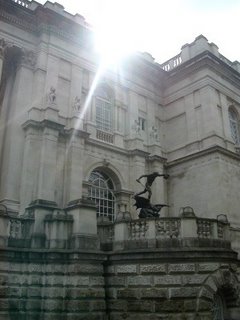
Right: The Tate Britain, North Side View
There are about a thousand good reasons to visit the Tate Gallery (Britain). Only one of them is that it’s a mile from my Kennington digs, just across the Vauxhall Bridge. The collection is vast, and you never see exactly the same mix twice, but the most famous pieces are probably up all the time to avoid disappointing visitors. If you love art there’s nothing to compare with walking into one large room and seeing absolutely lyrical works by Sargent, Waterhouse, Leighton, Burne-Jones, Rosetti, and Watts all around you. And I only mention the ones I came back to see again after my last visit two years ago. On a quieter day I would have stood and gazed at them even longer than I did, and having the luxury to go back when I like, you can be sure I will. Waterhouse’s The Lady of Shallot is worthy of long and loving contemplation, as is Sargent’s Carnation, Lily, Lily Rose, a study of dusk light and flowers and children, and Burne-Jones’ King Cophetua and the Beggar Maid, the most amazing portrayal of a man lost in love that anyone ever painted. Watts' Hope is an allegorical piece, somehow the perfect portrait of the word.
Only a couple of rooms over is John Everett Millais’ Ophelia, likewise breathtaking. Ophelia was praised by Millais’ contemporaries as a landscape, which is odd, because its central figure is a dead woman and they could scarcely have failed to notice that. The landscape features are remarkable: for one thing the entire painting is foreground; there’s no fading or diminution of detail from the grasses on our side of the bank to the flowers in dead Ophelia’s hands to the greenery on the far side. This lends an effect of in-your-face life to everything that surrounds poor Ophelia, who was modelled by Elizabeth Siddal, floating in a bath warmed by lamps underneath. The landscape was painted from life, in Surrey, which proves there is life in Surrey (Hi, Molly!), or at least there was in 1851.
And that’s just some 19th century frost on the tip of the British painting iceburg: 17 rooms cover roughly the period from 1600-1899, another 12 or so deal with the 20th onward (and one entire gallery downriver, the Tate Modern). One immense room the size of six of the others is dedicated to the paintings of Joseph Mallord William Turner, who left his works to the nation when he died.
The first time I saw a Turner realtime, I was in the National Gallery (the one in Trafalgar Square, not the one in Washington, D.C.). I turned a corner and there it was, and I swear I stopped breathing. It was The Fighting Temeraire Being Tugged to her Last Berth to be Broken Up . Now what, you may ask if you’ve never seen this painting, could be of anything more than historical interest about a picture of two ships going slow on an ocean? If you have seen it you probably don’t need to ask. Turner himself referred to this painting as "my darling," and refused to sell it. J.M.W. Turner was in the ground before the second half of the 19th century got out of first gear, but paintings like The Fighting Temeraire and The Burning of the Houses of Parliament should still be teaching painters something about modern art. The Turner Galleries at the Tate also contain a lot of earlier landscapes that don’t affect my breathing, but it’s amazing just to see so much of his life’s work in one room.
Of course another reason to go to the Tate Britain is to contemplate the paintings of Walter Richard Sickert (1860-1942). But that’s a subject for another (darker) day.





4 comments:
Wow. What an inspirational description! I'm not sure, but I think I am probably getting more out of your account than I would from looking at the paintings themselves.
Thanks, Bluejack. You should hear me when I go into detail...
"The Fighting Temeraire..." is in the National Gallery, so it's possible you never had occasion to come across it. Two ships on an ocean under a burning sky. Wow.
Patricia Cornwell's book "Portrait of a Serial Killer" named Sickert in no uncertain terms as Jack the Ripper. Not everyone agrees with her, and some dispute the way she chose which evidence to present, but unless she's lying about what the people at Scotland Yard said, they think they could convict the guy if he hadn't died of natural causes 44 years ago. Anyhow, I'm gonna write something about all that soon.
Post a Comment